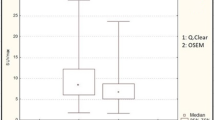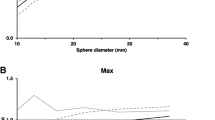Abstract
Aim/Introduction
Digital PET/CT allows Q.Clear image reconstruction with different Beta (β) levels. However, no definitive standard β level for [68 Ga]Ga-DOTANOC PET/CT has been established yet. As patient’s body mass index (BMI) can affect image quality, the aim of the study was to visually and semi-quantitatively assess different β levels compared to standard OSEM in overweight patients.
Materials and methods
Inclusion criteria: (1) patients with NEN included in a prospective CE-approved electronic archive; (2) [68 Ga]Ga-DOTANOC PET/CT performed on a digital tomograph between September2019/March2021; (3) BMI ≥ 25. Images were acquired following EANM guidelines and reconstructed with OSEM and Q.Clear with three β levels (800, 1000, 1600). Scans were independently reviewed by three expert readers, unaware of clinical data, who independently chose the preferred β level reconstruction for visual overall image quality. Semi-quantitative analysis was performed on each scan: SUVmax of the highest uptake lesion (SUVmax-T), liver background SUVmean (SUVmean-L), SUVmax-T/SUVmean-L, Signal-to-noise ratio for both liver (LSNR) and the highest uptake lesion (SNR-T), Contrast-to-noise ratio (CNR).
Results
Overall, 75 patients (median age: 63 years old [23–87]) were included: pre-obesity sub-group (25 ≤ BMI < 30, n = 50) and obesity sub-group (BMI ≥ 30, n = 25). PET/CT was positive for disease in 45/75 (60.0%) cases (14 obese and 31 pre-obese patients). Agreement among readers’ visual rating was high (Fleiss κ = 0.88) and the β1600 was preferred in most cases (in 96% of obese patients and in 53.3% of pre-obese cases). OSEM was considered visually equal to β1600 in 44.7% of pre-obese cases and in 4% of obese patients. In a minority of pre-obese cases, OSEM was preferred (2%). In the whole population, CNR, SNR-T and LSNR were significantly different (p < 0.001) between OSEM and β1600, conversely to SUVmean-L (not significant). These results were also confirmed when calculated separately for the pre-obesity and obesity sub-groups β800 and β1000 were always rated inferior.
Conclusions
Q.Clear is a new technology for PET/CT image reconstruction that can be used to increase CNR and SNR-T, to subsequently optimise overall image quality as compared to standard OSEM. Our preliminary data on [68 Ga]Ga-DOTANOC PET/CT demonstrate that in overweight NEN patients, β1600 is preferable over β800 and β1000. Further studies are warranted to validate these results in lesions of different anatomical region and size; moreover, currently employed interpretative PET positivity criteria should be adjusted to the new reconstruction method.
Similar content being viewed by others
References
Obesity and overweight. In World Health Organization. 2021. https://www.who.int/news-room/fact-sheets/detail/obesity-and-overweight. Accessed 3 Aug 2021
Sánchez-Jurado R, Devis M, Sanz R, Aguilar JE, del Puig CM, Ferrer-Rebolleda J. Whole-body PET/CT studies with lowered 18F-FDG doses: the influence of body mass index in dose reduction. J Nucl Med Technol. 2014. https://doi.org/10.2967/jnmt.113.130393.
Tatsumi M, Clark PA, Nakamoto Y, Wahl RL. Impact of body habitus on quantitative and qualitative image quality in whole-body FDG-PET. Eur J Nucl Med Mol Imaging. 2003. https://doi.org/10.1007/s0025900209805.
In GE Healthcare. 2021. https://www.gehealthcare.com. Accessed 3 Aug 2021
Parvizi N, Franklin JM, McGowan DR, Teoh EJ, Bradley KM, Gleeson FV. Does a novel penalized likelihood reconstruction of 18F-FDG PET-CT improve signal-to-background in colorectal liver metastases? Eur J Radiol. 2015. https://doi.org/10.1016/j.ejrad.2015.06.025.
Teoh EJ, McGowan DR, Bradley KM, et al. 18F-FDG PET/CT assessment of histopathologically confirmed mediastinal lymph nodes in non-small cell lung cancer using a penalised likelihood reconstruction. Eur Radiol. 2016. https://doi.org/10.1007/s00330-016-4253-2.
Sah BR, Stolzmann P, Delso G, et al. Clinical evaluation of a block sequential regularized expectation maximization reconstruction algorithm in 18F-FDG PET/CT studies. Nucl Med Commun. 2017. https://doi.org/10.1097/MNM.0000000000000604.
Wyrzykowski M, Siminiak N, Kaźmierczak M, Ruchała M, Czepczyński R. Impact of the Q.Clear reconstruction algorithm on the interpretation of PET/CT images in patients with lymphoma. EJNMMI. 2020; https://doi.org/10.1186/s13550-020-00690-6.
Bozkurt MF, Virgolini I, Balogova S, et al. Guideline for PET/CT imaging of neuroendocrine neoplasms with 68Ga-DOTA-conjugated somatostatin receptor targeting peptides and 18F-DOPA. Eur J Nucl Med Mol Imaging. 2017. https://doi.org/10.1007/s00259-017-3728-y.
Usmani S, Ahmed N, Gnanasegaran G, et al. The clinical effectiveness of reconstructing 18F-sodium fluoride PET/CT bone using Bayesian penalized likelihood algorithm for evaluation of metastatic bone disease in obese patients. Br J Radiol. 2021. https://doi.org/10.1259/bjr.20210043.
Lindström E, Lindsjö L, Sundin A, Sörensen J, Lubberink M. Evaluation of block-sequential regularized expectation maximization reconstruction of 68Ga-DOTATOC, 18F-fluoride, and 11C-acetate whole-body examinations acquired on a digital time-of-flight PET/CT scanner. EJNMMI Phys. 2020. https://doi.org/10.1186/s40658-020-00310-1.
Roef MJ, Rijnsdorp S, Brouwer C, Wyndaele DN, Arends AJ. Evaluation of quantitative Ga-68 PSMA PET/CT repeatability of recurrent prostate cancer lesions using both OSEM and Bayesian penalized likelihood reconstruction algorithms. Diagnostics (Basel). 2021. https://doi.org/10.3390/diagnostics11061100.
Teoh EJ, McGowan DR, Schuster DM, Tsakok MT, Gleeson FV, Bradley KM. Bayesian penalised likelihood reconstruction (Q.Clear) of 18F-fluciclovine PET for imaging of recurrent prostate cancer: semi-quantitative and clinical evaluation. Br J Radiol. 2018; https://doi.org/10.1259/bjr.20170727
Teoh EJ, McGowan DR, Macpherson RE, Bradley KM, Gleeson FV. Phantom and clinical evaluation of the Bayesian penalized likelihood reconstruction algorithm Q.Clear on an LYSO PET/CT System. J Nucl Med. 2015; https://doi.org/10.2967/jnumed.115.159301
Matti A, Lima GM, Pettinato C, Pietrobon F, Martinelli F, Fanti S. How do the more recent reconstruction algorithms affect the interpretation criteria of PET/CT images? Nucl Med Mol Imaging. 2019. https://doi.org/10.1007/s13139-019-00594-x.
Witkowska-Patena E, Budzyńska A, Giżewska A, Dziuk M, Walęcka-Mazur A. Ordered subset expectation maximisation vs Bayesian penalised likelihood reconstruction algorithm in 18F-PSMA-1007 PET/CT. Ann Nucl Med. 2020. https://doi.org/10.1007/s12149-019-01433-x.
Chicheportiche A, Goshen E, Godefroy J, et al. Can a penalized-likelihood estimation algorithm be used to reduce the injected dose or the acquisition time in 68Ga-DOTATATE PET/CT studies? EJNMMI Phys. 2021. https://doi.org/10.1186/s40658-021-00359-6.
Lantos J, Mittra ES, Levin CS, Iagaru A. Standard OSEM vs. regularized PET image reconstruction: qualitative and quantitative comparison using phantom data and various clinical radiopharmaceuticals. Am J Nucl Med Mol Imaging. 2018;8(2):110–18.
Adler S, Seidel J, Choyke P, Knopp MV, Binzel K, Zhang J, Barker C, Conant S, Maass-Moreno R. Minimum lesion detectability as a measure of PET system performance. EJNMMI Phys. 2017. https://doi.org/10.1186/s40658-017-0179-2.
Adams MC, Turkington TG, Wilson JM, Wong TZ. A systematic review of the factors affecting accuracy of SUV measurements. AJR Am J Roentgenol. 2010. https://doi.org/10.2214/AJR.10.4923 Erratum in: AJR Am J Roentgenol. 2010.
Cheson BD. Staging and response assessment in lymphomas: the new Lugano classification. Chin Clin Oncol. 2015. https://doi.org/10.3978/j.issn.2304-3865.2014.11.03.
Author information
Authors and Affiliations
Contributions
Conceptualization: [all authors]; Methodology: [Valentina Ambrosini, Stefano Fanti, Diletta Calabrò, Lucia Zanoni]; Formal analysis and investigation: [Lucia Zanoni, Diletta Calabrò, Emilia Fortunati, Giulia Argalia, Vincenzo Allegri, Simona Civollani, Davide Campana, Valentina Ambrosini], Statistical analysis [Claudio Malizia], Writing—original draft preparation: [Lucia Zanoni, Valentina Ambrosini]; Writing—review and editing: [all authors]; Supervision: [Stefano Fanti, Valentina Ambrosini]. All authors meet the criteria for authorship.
Corresponding author
Ethics declarations
Ethics approval and consent to participate
All procedures, performed in studies involving human participants, were in accordance with the ethical standards of the institutional and/or national research committee and with the 1964 Helsinki Declaration and its later amendments or comparable ethical standards. The study was approved by the Institutional Ethics Committee (electronic archive 131/2017/O/Oss). Informed consent to participate was obtained from all individual participants included in the study.
Conflict of interest
SF reports personal fees from ANMI, Astellas, Bayer, BlueEarth Diagnostics, GE Healthcare, Jenssen, Novartis, Sofie Biosciences, non-financial support from AAA, Bayer, GE Healthcare, Curium, Tema Sinergie, Sanofi, Telix, outside the submitted work; VAmbrosini reports personal fees from ESMIT and AAA outside the submitted work and is a member of ENETS advisory board, EANM oncology and theranostic commitee, ESMO faculty staff for NET and the scientific board of ITANET; DCalabrò reports personal fees from ESMIT outside the submitted work; LZ reports personal fees from ESMIT and Springer outside the submitted work. DCampana, EF, GA, CM, VAllegri and SC declare no competing interests.
Additional information
Publisher’s note
Springer Nature remains neutral with regard to jurisdictional claims in published maps and institutional affiliations.
This article is part of the Topical Collection on Oncology - General
Rights and permissions
About this article
Cite this article
Zanoni, L., Argalia, G., Fortunati, E. et al. Can Q.Clear reconstruction be used to improve [68 Ga]Ga-DOTANOC PET/CT image quality in overweight NEN patients?. Eur J Nucl Med Mol Imaging 49, 1607–1612 (2022). https://doi.org/10.1007/s00259-021-05592-w
Received:
Accepted:
Published:
Issue Date:
DOI: https://doi.org/10.1007/s00259-021-05592-w




